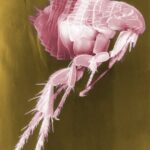What Are Water Fleas?
Water fleas are tiny planktonic crustaceans in the order Anomopoda. They range in length from 0.2 to 6.0 mm. They are most commonly known as water fleas because of their swimming style, which is similar to that of a flea.
The most common species of water flea is Daphnia pulex. They swim like a flea and have a flat, folded shell-like body structure, or carapace. Daphnia pulex has a small, flat head, a pair of antennae, and a bivalve carapace.
These insects live in freshwater habitats and filter water for bacteria and organic matter. They also have a brood chamber to lay eggs, which develop into larvae. They feed on microscopic organic matter. Because they are filter feeders, water fleas filter water using their specialized limbs.
Water Fleas reproduce by parthenogenesis, which means that they reproduce without the assistance of males. Females lay fertile eggs in their brood pouch, which is a sac like a knapsack. The pouch can hold up to 20 eggs. Female Water Fleas carry their eggs in this pouch and swim upside-down until the eggs hatch. These larvae will eventually grow into exact replicas of their mother.
When keeping water fleas, it’s best to keep them in separate rooms. If possible, keep them away from formalin, which can kill them quickly. Also, try not to expose the cladocerans to air, since they will become stranded at the air-water surface. Lastly, you should allow them to adjust to the water temperature before reintroducing them to their home.








